Introduction à l'analyse Elliott Wave
Les informations données ne sont pas des conseils en investissement
En quoi consiste l'analyse d'Elliott Wave ?
Vous avez probablement entendu parler des vagues d'Elliott ou même vu des comptages de vagues. En effet, l'analyse des vagues d'Elliott est aujourd'hui l'une des approches les plus populaires afin d'anticiper le marché du Forex. Pourquoi ? La théorie des vagues d'Elliott est le seul outil qui permet de trier le mouvement des prix à chaque échéance, du caractère mensuel ou même annuel à un intervalle infra-journalier d’une minute. Par exemple, vous pouvez trader avec des graphiques intrajournaliers, mais en même temps, vous pouvez également avoir une image plus grande. En termes simples, les vagues d'Elliott sont l’ADN du marché. Dans les articles suivants, nous allons vous guider à travers la théorie des vagues d'Elliott. Allons-y.
Qui en est l'auteur ?
Nous devrions remercier chaleureusement Ralph Nelson Elliott (1871 - 1948), qui était comptable et économiste. En 1938, il publie "The Wave Principle" et son deuxième livre "Nature's Law - The Secret of the Universe" est imprimé en 1946. Elliott décrit des figures qui se forment de manière répétée sur le marché selon des règles très bien définies.
Nous devons également remercier Robert R. Prechter Jr. et A.J. Frost pour le livre "Elliott Wave Principle: Key to Market Behavior", qui est aujourd'hui la principale source de règles et de directives. De plus, en 2006, un autre excellent livre a été publié - "Elliott's Code" de D.V. Vozny. Malheureusement pour de nombreux lecteurs du monde entier, ce livre est en russe.
Le début du voyage
Cette série d'articles se base sur les deux livres. Toute règle ou directive que vous trouverez ici correspond aux règles de ces publications. Et rassurez-vous, je ne vais pas simplement vous répéter ce qu'il y a dans les livres, je vais essayer de vous enseigner la théorie des vagues d'Elliott d'une manière simple et ce, tout en partageant mon expérience. La plupart des exemples viendront du marché réel. En outre, nous allons passer en revue certains cas, qui ne sont pas décrits dans les livres, mais vous pouvez les trouver sur les graphiques.
LEGO du marché
La théorie des vagues d’Elliott repose sur deux éléments principaux : les impulsions (mouvements de prix à cinq vagues) et les corrections (mouvements de prix à trois vagues). Nous y reviendrons dans les prochains articles, vous verrez donc qu'il n'y a qu'un seul bloc LEGO, qui est une impulsion. Mais pour l'instant, concentrons-nous sur ces deux-là.
Regardons le tableau ci-dessous. Vous pouvez voir là un déclin de 5 vagues - c'est une vague impulsive (il y a des cas où nous pourrions avoir une correction de 5 vagues, mais je vais en parler plus tard). En outre, il y a une avance de 3 vagues, que nous pourrions envisager comme une correction. Bien, nous venons de trouver une impulsion et une correction, il est donc temps de regarder un graphique un peu plus grand.
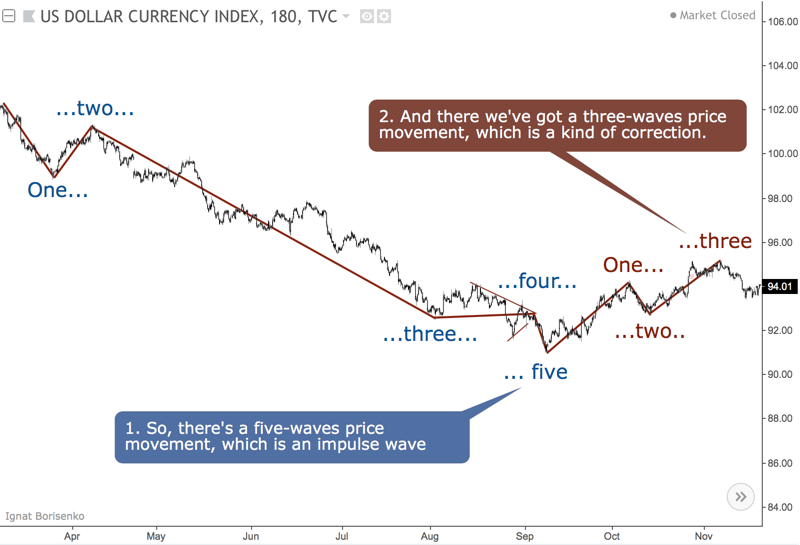
Le graphique suivant est juste le nombre réel de vagues que j'ai publié dans mes analyses. Le déclin est probable dans la troisième vague d'une impulsion baissière, tandis que la quatrième vague est celle d'un rebond à la hausse.

Nous pouvons donc en arriver à la conclusion suivante : il n’y a pas de vague qui puisse rester à part des autres. La théorie des vagues d'Elliot fonctionne comme une poupée russe (Matryoshka). Chaque vague fait partie d'une autre vague, mais chaque vague est composée de vagues plus petites. Cette histoire va d'intervalles de temps plus longs à des intervalles de temps plus courts.
Cela rend la théorie des vagues d'Elliot différente des autres techniques d'analyse de marché. La majorité des approches d'analyse technique se concentrent sur les figures et les signaux, qui se distinguent les uns des autres. La puissance de la la théorie des vagues d'Elliot réside dans sa capacité à considérer le graphique dans son ensemble, et pas seulement via une configuration unique.
Opportunités de réflexion
Vous avez probablement déjà entendu dire que si vous utilisiez la théorie des vagues d'Elliot dans le trading, il y a différent modes de comptage. Habituellement, il y a plusieurs scénarios possibles, parfois contradictoires. C'est ce qui est le plus excitant avec la théorie des vagues d'Elliot parce que c'est un peu comme jouer aux échecs.
Si un indicateur du Saint-Graal vous dit d'acheter ou de vendre, vous ne pensez pas à ce que vous allez faire si quelque chose ne se déroule pas bien. Avec la théorie des vagues d'Elliot, vous essayez de déterminer les opérations de trading en fonction du nombre de vagues en place. C'est une compétence essentielle afin d'être un trader prospère.
Exemples réels
Prenons l'exemple de l'indice DJI. En septembre 2016, l'indice a atteint son plus haut niveau historique et j'ai publié un nombre de vagues plutôt haussier. Je m'attendais à un marché beaucoup plus élevé, car la cinquième vague était loin d'être terminée.
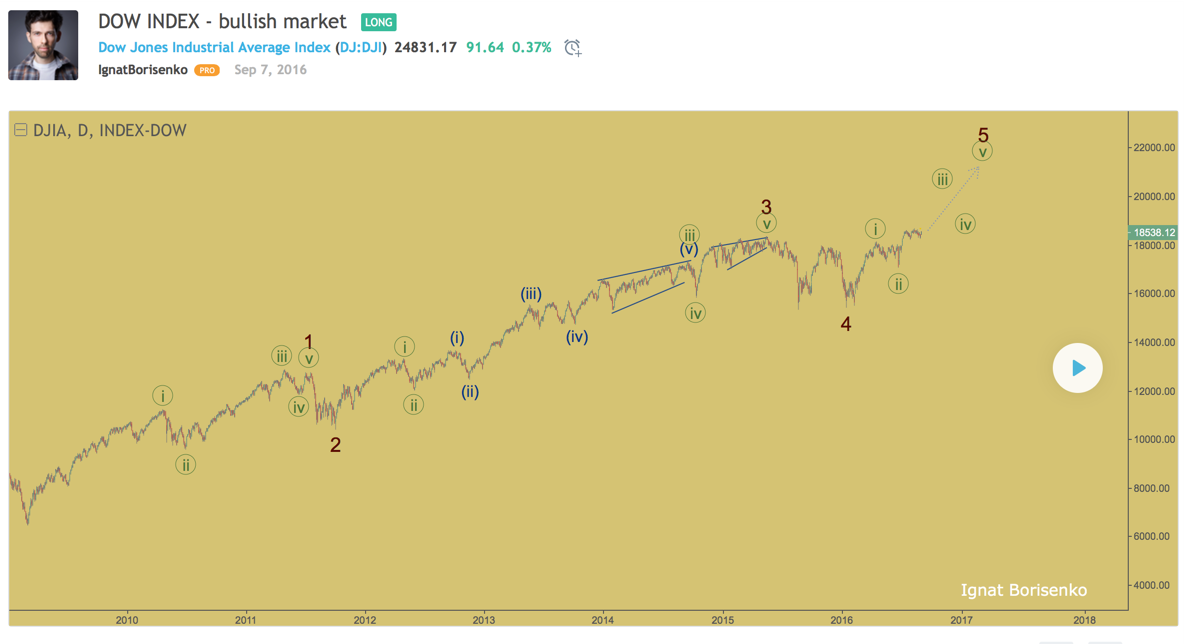
Quelques mois plus tard, le marché a grimpé encore plus haut, mais j'étais toujours haussier. Cette attente était basée sur certaines choses de la théorie des vagues d'Elliott que nous allons bientôt découvrir, mais pour le moment, vous pouvez déjà voir comment cela fonctionne.
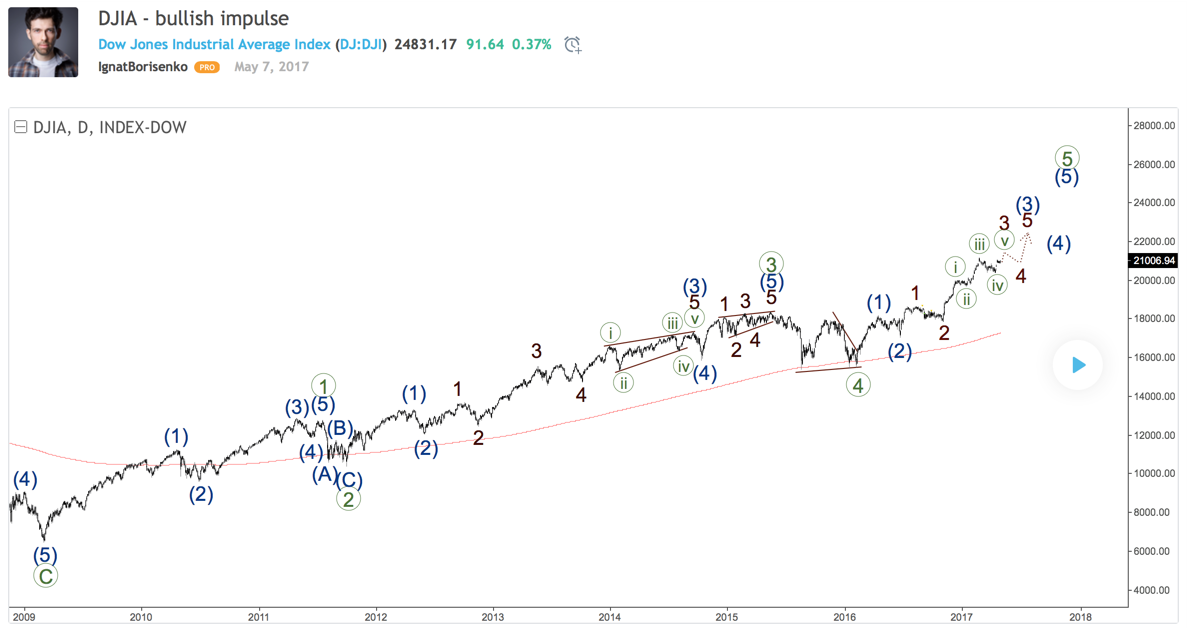
La tendance est donc toujours haussière et vous pouvez voir le nombre de vagues actuel ci-dessous.

La deuxième histoire concerne la paire USD/TRY. En octobre 2016, la quatrième vague semblait se terminer comme un triangle, alors je m'attendais à une autre impulsion haussière, qui s'est développée au cours des prochains mois.
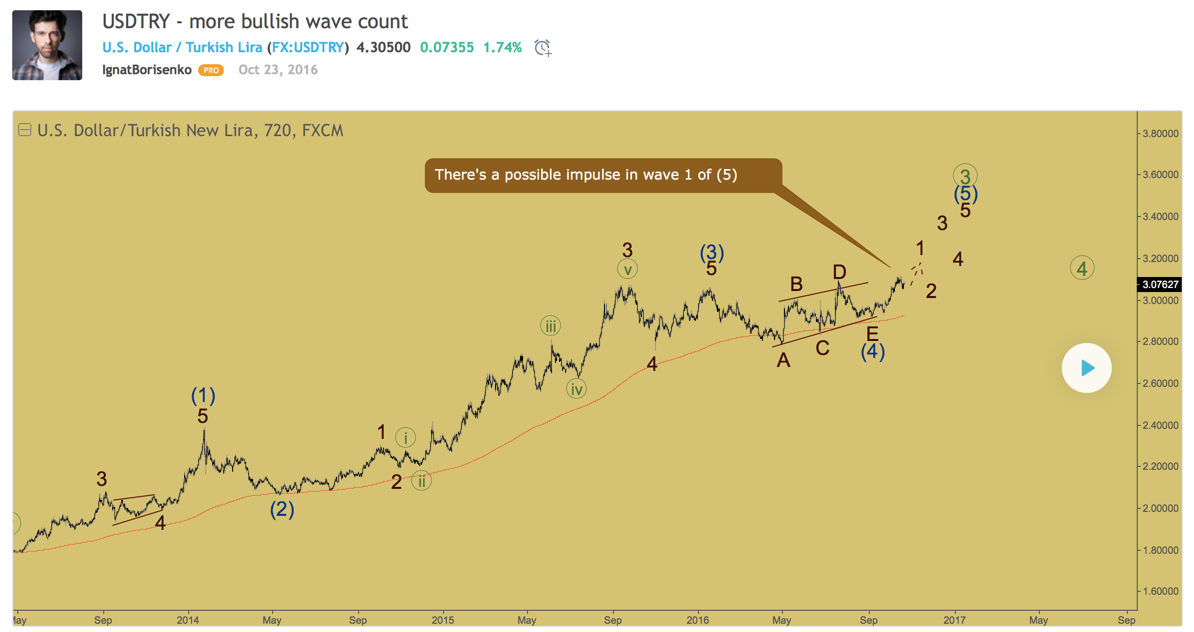
Puis il y a eu une longue histoire avec une correction baissière, qui s'est finalement terminée, donc la tendance haussière s'est poursuivie comme prévu.
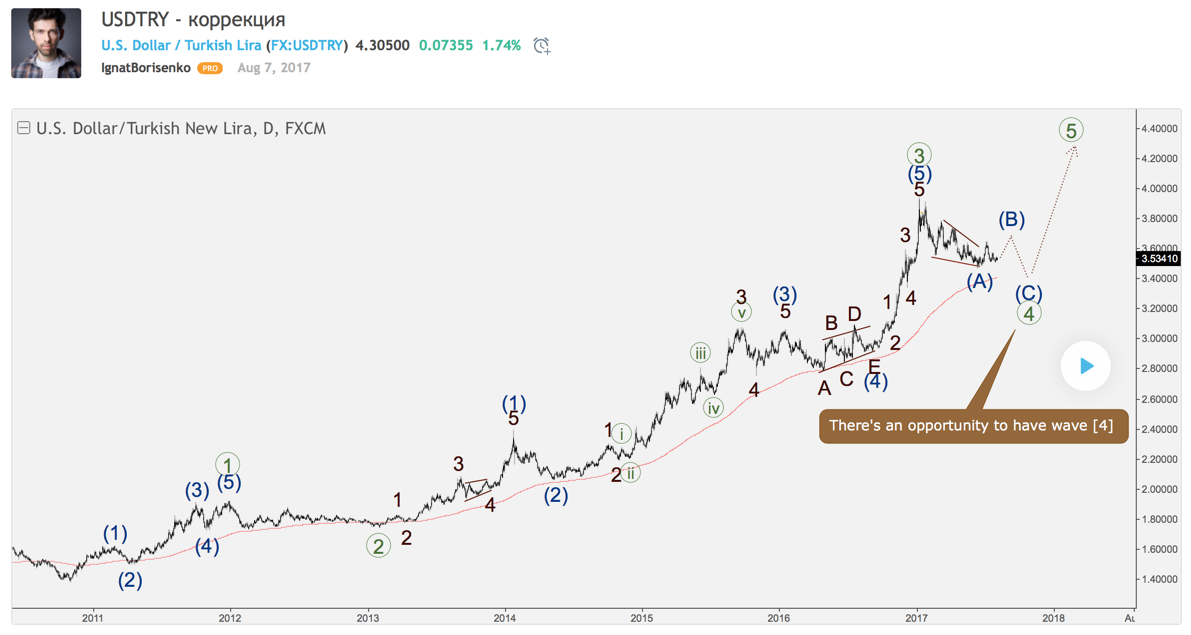
Enfin, en avril 2018, il y a eu un autre moment haussier en raison de la fin possible de la vague 4. Le marché est donc allé encore plus haut.
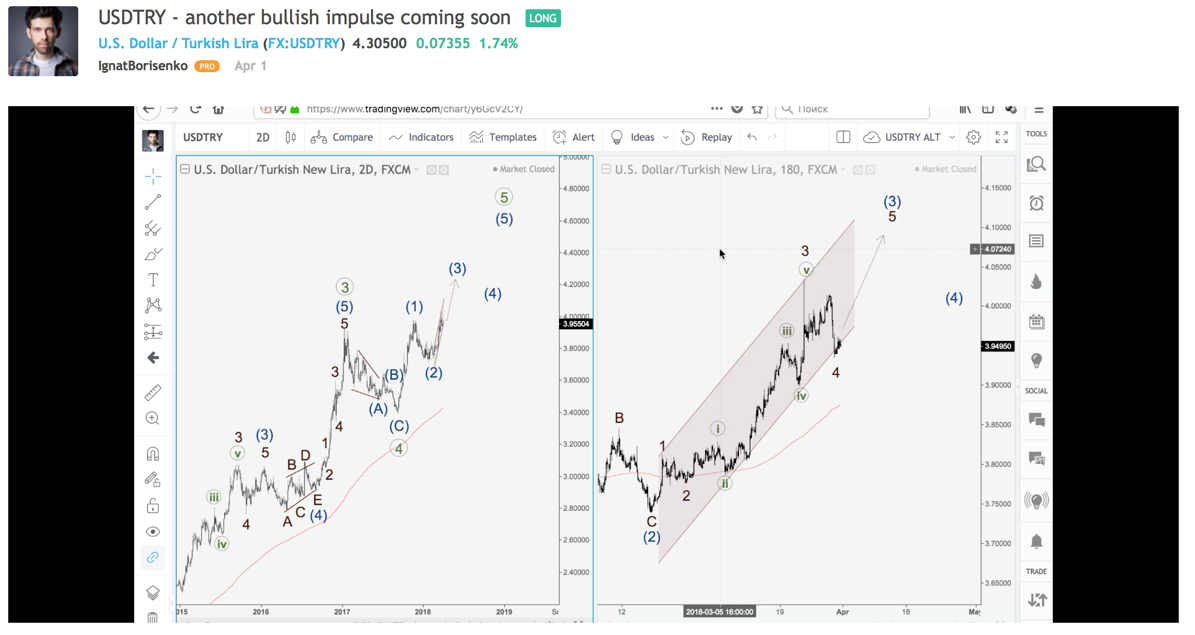 Ligne de fond
Ligne de fond
Il y a aussi de mauvais exemples. Cependant, en ce qui concerne le trading, le plus important est ce que vous faites lorsque le marché évolue dans le sens de la tendance en fonction du nombre de vagues. Nous pouvons donc utiliser la théorie des vagues d'Elliott comme un excellent outil afin d'identifier des opportunités sur les marchés.
De plus, vous n'êtes pas obligé de trader le nombre de vagues que vous avez étiquetées ou juste vues sur le Web. Vous ne devriez trader que les meilleurs comptes lorsque vous avez un bon moment pour ouvrir un trade. En d'autres termes, vous devriez attendre un bon appel un peu comme un chasseur dans les bois. Et lorsque vous voyez une opportunité, faites de votre mieux afin de trader avec le plus de succès possible.
C'est juste le début. Dans les prochains articles, nous examinons les règles et directives plus spécifiques de la théorie des vagues d'Elliott.
Autres articles de cette section
- Structure d'un robot de trading
- Concevoir un robot de trading sans programmation
- Comment lancer des robots de trading avec MetaTrader 5 ?
- Trading algorithmique : de quoi s'agit-il ?
- Trading d'algo avec MQL5
- En quoi consiste le principe de la "troncature" ?
- Ichimoku
- Figure de diagonale d'initialisation
- Le modèle des vagues de Wolfe
- Modèle des "Three drives"
- Shark
- Papillon
- Crabe
- Chauve-souris (bat)
- Gartley
- ABCD
- Les figures harmoniques
- Comment trader sur les cassures
- Actualités sur le Forex
- Comment placer un ordre Take Profit ?
- Gestion des risques
- Comment placer un ordre Stop Loss ?
- Indicateurs techniques: trading des divergences











